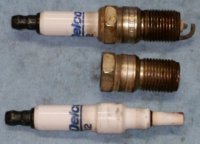Another little lathe project. I've been wanting to check if the timing mark on my OEM rotor is really showing TDC. 4 things have to be precisely positioned to get an accurate TDC indication.
- The keyway slot in the crank.
- The keyway slot in the rotor.
- The notched mark on the rotor's slipring face.
- The markings on the stator cover
Understandable if there's some inaccuracies there.
Borrowing from the "piston stop" method for finding true TDC. Instead of stopping the piston, this version has a plunger to sense piston position. It's no more electronic than a set of points or brake switch. It just provides a grounding signal when the piston is just slightly below TDC.
I won't bore you with all the lathe operations. They're simple turning routines, but the fit of the plunger within the sparkplug shell must be kept close, like less than 0.001" plunger/bore diametrical difference. Otherwise, the plunger position would be too indeterminate.
A sparkplug's ground lug is cut off, the retaining crimp is machined off the top of the metal shell. Tap on the center electrode with a punch, drive out the porcelain core.

The shell must be precision bored to get a close sliding fit with the plunger.
This one uses a 3/8" (0.375") plunger.
Here's the finished parts for the tool. Stainless steel plunger, black plastic insulator, brass disc, steel guide rod threaded to #4-40.

- The keyway slot in the crank.
- The keyway slot in the rotor.
- The notched mark on the rotor's slipring face.
- The markings on the stator cover
Understandable if there's some inaccuracies there.
Borrowing from the "piston stop" method for finding true TDC. Instead of stopping the piston, this version has a plunger to sense piston position. It's no more electronic than a set of points or brake switch. It just provides a grounding signal when the piston is just slightly below TDC.
I won't bore you with all the lathe operations. They're simple turning routines, but the fit of the plunger within the sparkplug shell must be kept close, like less than 0.001" plunger/bore diametrical difference. Otherwise, the plunger position would be too indeterminate.
A sparkplug's ground lug is cut off, the retaining crimp is machined off the top of the metal shell. Tap on the center electrode with a punch, drive out the porcelain core.

The shell must be precision bored to get a close sliding fit with the plunger.
This one uses a 3/8" (0.375") plunger.
Here's the finished parts for the tool. Stainless steel plunger, black plastic insulator, brass disc, steel guide rod threaded to #4-40.
Last edited:
